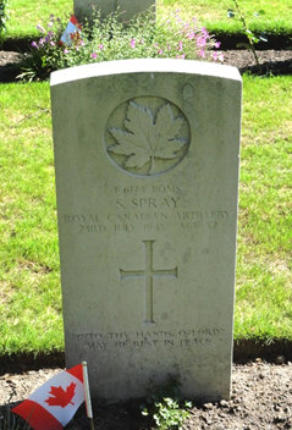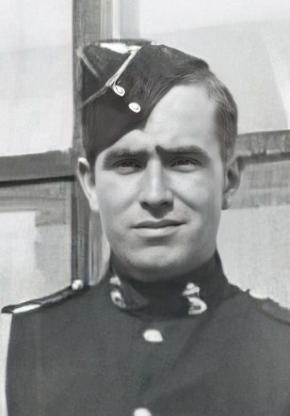
copyright © Wartime Heritage Association
Website hosting courtesy of Register.com - a web.com company
Wartime Heritage
ASSOCIATION
Remembering World War II
Name:
Stanley Eric Spray
Rank:
Battery Quartermaster Sergeant
Service Number:
F/6174
Service:
3 Anti-Tank Regiment, Royal Canadian Artillery
Date of Birth:
April 24, 1913
Place of Birth:
Nottingham, Nottinghamshire, England
Date of Enlistment:
July 6, 1940
Place of Enlistment:
Aldershot, Kings County, Nova Scotia
Address at Enlistment:
Digby, Digby County, Nova Scotia
Age at Enlistment:
27
Height:
5 feet, 5 inches
Complexion:
Medium
Hair Colour:
Brown
Eye Colour:
Blue
Occupation:
Printer
Marital Status:
Married
Religion:
Church of England
Next of Kin:
Alda May Spray (Wife)
Date of Death:
July 23, 1945
Age:
32
Cemetery:
Groesbeek Canadian War Cemetery, Netherlands
Grave:
Section I, Row A, Grave 12
Commemorated on Page 566 of the Second World War Book of Remembrance
Displayed in the Memorial Chamber of the Peace Tower in Ottawa on November 26
Stanley Eric Spray was the son of Edgar Spray (1881-1957) and Edith May (Dean) Spray (1884-1975) of
Wollaton, Nottinghamshire, England, and the husband of Alda May (Turnbull) Spray (1913-1990), of Digby,
Nova Scotia. Stanley’s father was a colliery bank foreman in mining and his mother was employed as a lace
finisher in Nottinghamshire. Stanley and Alda had two children - Jean Caroline Spray and Joan Carol Spray.
Stanley’s siblings were Edith May Spray (1904-1970), Beatrice Spray (1906-1934), Ethel Spray (1909-2002),
Hilda Spray (1914-1998), and Norman Spray (192-1942). His brother Sergeant Norman Spray, a pilot, was
killed April 29, 1942, over Germany serving with the Royal Air Force’s 12 Squadron.
Stanley Spray was a British home child who emigrated to Canada by the Dakeyne Boy’s Farm at the age of 14
in 1928.
In 1912, Oliver Hind, with the help of Mr. John Player and the Dakeyne Lads Club of Nottingham, England
bought 250 acres in Mount Denson, Hants Co., Nova Scotia. He established a home for boys (and two girls)
aged 15 to 18, who with the consent of their parents, volunteered to come to Canada to learn the ways of
Farming. Hind\s objective was to prevent these boys, for lack of better opportunity, from drifting into casual
employment. Once they arrived at the farm, they spent several months training before being hired out to
local farmers. In 1935, John Ingram Wilson purchased the farm, and it has remained in his family ever since.
On June 2, 1928, Stanley arrived in Halifax aboard the SS Newfoundland of the Furness Line which had
departed Liverpool on May 23, 1928. From the city, Stanley was taken to the Dakeyne Farm in Falmouth,
Hants Co., NS between Mount Denson and Windsor.
Little is known of his time there, but Stanley did remain in Nova Scotia throughout the 1930’s and enlisted
for service in the Second World War in July of 1940. He ran a small farm and worked for J. J. Wallis as a
printer before his enlistment.
After enlistment and training in Canada, Stanley served as an orderly room clerk until October 5, 1942, and
on the No. 1 gun crew from October 1942 until May 2, 1943, when he became a Battery Quartermaster
Sergeant.
Stanley departed Halifax for Liverpool, England on October 5, 1941.
He transferred to France from the UK on June 26-28, 1944.
The Battery Quartermaster Sergeant was the senior NCO responsible the battery's logistics. On July 22, 1944,
he was involved in a military vehicle accident at approximately 11:30 pm on the Amersfoort-Apeldoorn
Highway in Holland. His vehicle (CL4266502) was returning from a duty trip to Utrecht.
An army lorry (vehicle CZ4256075) had swerved toward the
center line to avoid colliding with civilians pushing a cart on
the side of the road, and side-swiped the lorry Stanley was
travelling in with the Battery Sergeant Major WE Lifford
(Service No. G/5019) and artillery Gunner Ward. Riding in the
rear of the truck, Stanley was thrown from it and pinned
under a wheel.
He was transported by jeep to the No. 5 Canadian Casualty
Clearing Station, of the Royal Canadian Army Medical Corps, at
5 minutes past midnight on July 23, 1944. 20 minutes later,
he succumbed to his wounds.
Battery Quartermaster Sergeant Spray is interred at the
Groesbeek Canadian War Cemetery in the Netherlands.
Stanley Spray






- World War I - Menu
- WWI Stories and Articles
- Photos - Yarmouth Soldiers
- Selection of World War I Songs
- WWI Casualties of Yarmouth, NS
- Those Who Served - Yarmouth, NS
- WWI Casualties Digby Co. NS
- WWI Casualties Shelburne Co. NS
- Merchant Mariners (1915) Yarmouth, NS
- Canadian Forestry Corps - Non Yarmouth Birth/Residence Enlistments
- US Draft Registry - Yarmouth NS Born


- World War II - Menu
- WWII Stories and Articles
- Telegraphist Air Gunners
- WWII Casualties of Nova Scotia
- US Casualties with NS Connection
- Far East/Pacific Casualties with NS Connection
- Merchant Navy Casualties Nova Scotia
- Nova Scotia WWII Casualties Holten Canadian War Cemetery
- D-Day Casualties - Nova Scotia
- CANLOAN Program Casualties - Nova Scotia
- Battle of the Bulge Casualties - Nova Scotia
- WWII Casualties Yarmouth NS
- Yarmouth Casualties - RCAF RAF Canadian Army WWII
- Yarmouth Co., Marriages WWII
- Casualties Non-Born/Residents with Connection to Yarmouth Co., Nova Scotia.
- WWII Casualties Digby Co., NS
- Non-Nova Scotian WWII Casualties Buried in Nova Scotia
- WWII RCAF Casualties Aged 16-18
- Brothers/Sisters Who Served - World War II













